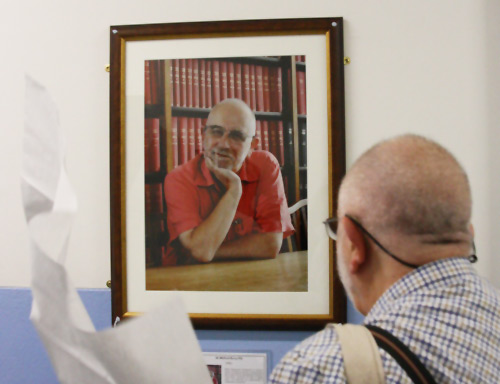Tag archives: waves
Michael Berry at 75

A moment to reflect – Michael Berry unveils a framed photograph of himself in the University of Bristol at an event to mark his 75th birthday. (Courtesy: Brian R Pollard)
By Matin Durrani
Anyone who gets invited to an event that’s being held on April Fools’ Day is bound to think there’s something fishy going on. But last Friday’s meeting to celebrate the 75th birthday of Bristol University physicist Michael Berry was a genuine commemoration of his career, although it did have its lighter moments.
Grandly entitled “Physics, Art, Mathematics, Science”, the meeting was intended to reflect Berry’s extensive and wide-ranging interests, which stretch from the physics of waves and quantum phenomena to optics, tidal bores and magnetic levitation. (There’s also a phenomenon called the Berry phase, although I understand Berry himself is reluctant to use that term.)
It’s difficult to summarize Berry’s many contributions to physics – he has written approaching 500 papers – so I’m going to take the easy way out and instead point you at his excellent website, where you can easily get lost down lots of entertaining and stimulating rabbit holes.
If there’s one item on his site I can recommend, it’s his description of how his work on the mathematics of magnetic levitation led him to share the 2000 IgNobel Prize for Physics with the future (genuine) Nobel laureate Andre Geim, who in 1997 levitated a frog using a powerful permanent electromagnet while at Bristol.
View all posts by this author | View this author's profile
How Charles Wheatstone got to see polarization
By Matin Durrani
Things seem to have quietened down a bit following last month’s announcement by astronomers in the BICEP2 collaboration that they had obtained the first evidence of cosmic inflation – the period of rapid expansion in the first fraction of a second after the Big Bang. As you’ll know if you’ve been keeping up, the evidence was obtained by searching for certain “B-mode” polarizations in the cosmic microwave background, which are related to primordial gravitational waves that are thought to have abounded in the early universe. These polarizations differ from “E-mode” polarization, which describes how the magnitude of polarization varies across the CMB.
But never mind your fancy B-modes and E-modes, how well do you understand the concept of polarization in the first place? Intriguingly, in the late 1840s Sir Charles Wheatstone, who was then professor of experimental philosophy at the University of London, decided to create a mechanical device to explain the principles of the concept – several decades before James Clerk Maxwell’s theory of the electromagnetic nature of light.
The video above shows a rare surviving example of one of these “Wheatstone Wave Machines”, which has been restored to working order by Robert Whitworth and colleagues at the University of Birmingham in the UK as part of their collection of historic physics instruments. Wheatstone designed the machine to visualize the wave nature of light and offer what Whitworth calls “a vivid insight into the theoretical concepts of wave motion”. At the time, there were other devices that showed the behaviour of travelling plane waves, but Wheatstone’s was different in that it was the first to demonstrate circularly polarized light.
View all posts by this author | View this author's profile
Reawakening the Kelvin wake

Wake angles: the black dashed line shows the outer edge of the wake and is at the angle predicted by Lord Kelvin. The red line shows the maximum amplitude of the wake and is at the angle predicted by Marc Rabaud and Frédéric Moisy. (Courtesy: A Darmon, M Benzaquen, E Raphaël)
By Hamish Johnston
Loyal readers may recall that earlier this year we published a news article entitled “Physicists rethink celebrated Kelvin wake pattern for ships” that reported on work done by two French physicists. While looking at Google Earth images of ships moving through the sea, Marc Rabaud and Frédéric Moisy noticed that some of the wakes did not conform to a prediction made years ago by Lord Kelvin, the renowned Victorian physicist, engineer and entrepreneur.
View all posts by this author | View this author's profile